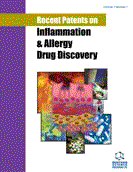Abstract
Background: Several compositions for determination of specific molecular components in allergens have recently been patented. The role of Molecular Allergy (MA) diagnostics in suspected IgE mediated allergic conditions is currently debated. Guideline reports have concluded that population- based studies involving evaluation of the usefulness of MA diagnostics are needed.
Objective: To evaluate the usefulness of MA diagnostics in a secondary pediatric referral center.
Methods: A total of 961 children and adolescents aged 0.2-18.8 (mean 7.0) years was included in a prospective observational survey. Inclusion criterion was a suspected diagnosis of an IgE mediated condition based on history and clinical symptoms and signs. If a specific diagnosis could not be reached from conventional investigations suspected peanut allergy, birch pollen allergy and associated crossreactivity, insect allergy and triggering allergens for specific immunotherapy were assessed by MA diagnostics.
Results: Based on conventional work-up a diagnostic conclusion was established in 946 patients (98.4%). MA diagnostics were performed in 15 individuals (1.6%), 7 girls and 8 boys aged 3.2 to 17.8 (mean 10.6) years. In 8 cases a specific diagnosis was established based on MA diagnostics; in 7 cases MA diagnostics could not improve diagnosis. MA were most frequently (N = 7 (14%)) used in children with peanut allergy (N = 50).
Conclusion: Most patients in a secondary pediatric referral center with suspected IgE mediated allergy can be managed by conventional diagnostic methods. MA diagnostics may be useful in small and selected subgroups as in patients with suspected peanut allergy, however, may not be helpful in all cases.
Keywords: Allergy, asthma, component resolved diagnosis, eczema, molecular allergy diagnostics, peanut, rhinitis, urticaria.
[http://dx.doi.org/http://dx.doi.org/10.1111/pai.12563]
[http://dx.doi.org/http://dx.doi.org/10.1186/1939-4551-6-17] [PMID: 24090398]
[http://dx.doi.org/http://dx.doi.org/10.5420/2012/806920]
[http://dx.doi.org/http://dx.doi.org/10.1186/s40413-017-0162-3] [PMID: 28959378]
[http://dx.doi.org/http://dx.doi.org/10.1111/j.1399-3038.2006.00429.x] [PMID: 17014628]
[http://dx.doi.org/http://dx.doi.org/10.1111/j.1398-9995.1990.tb01080.x] [PMID: 2309986]
[http://dx.doi.org/http://dx.doi.org/10.1111/j.1398-9995.2001.00921.x] [PMID: 11298014]
[http://dx.doi.org/http://dx.doi.org/10.1111/cea.12899] [PMID: 28160326]
[http://dx.doi.org/http://dx.doi.org/10.1007/s11882-010-0133-z] [PMID: 20628838]
[http://dx.doi.org/http://dx.doi.org/10.1016/j.jaip.2018.04.040] [PMID: 29782938]
 21
21 3
3 1
1 1
1


















